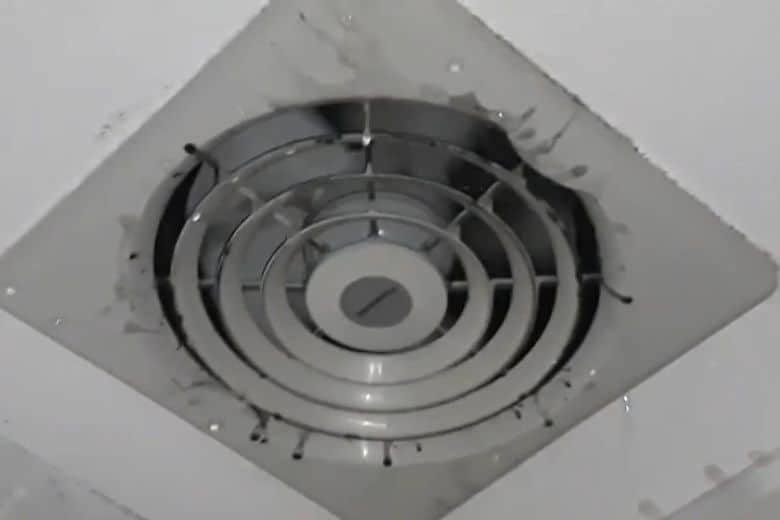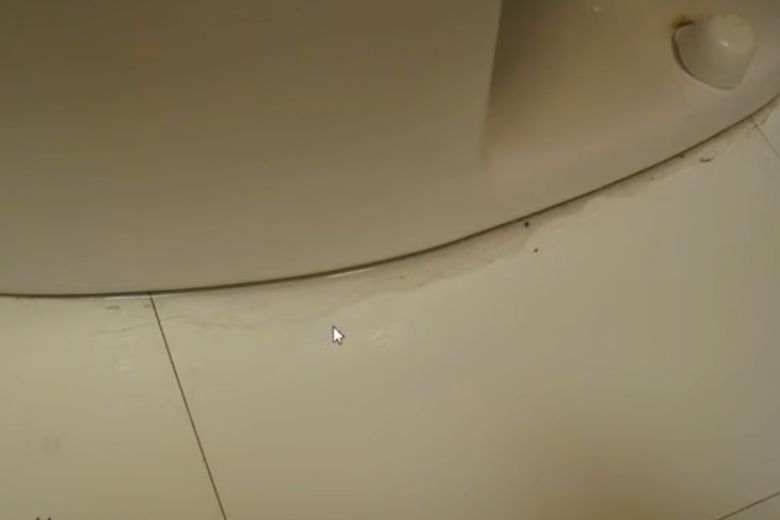Is your bathroom exhaust fan causing water leaks and leaving you perplexed? If you answer yes, you have come to the right place. Because today, we will discuss how to fix bathroom exhaust fan leaking water.
However, leaking water could be due to a blocked vent, damaged vent pipe, improper installation, or excessive humidity levels in the bathroom. Water dripping from your exhaust fan can lead to mold growth, ceiling stains, and even damage to your bathroom fixtures.
But fear not!
Meanwhile, if you understand the root causes and follow some straightforward troubleshooting steps. You can easily fix this issue, restore your bathroom’s ventilation system, and regain its excellent performance.
Understanding the Causes of a Leaking Bathroom Exhaust Fan
Understanding the causes behind a leaking bathroom exhaust fan is important before attempting to solve the problem. We have pointed out a few possible reasons why your bathroom exhaust fan leaks water. Have a look.
1. Condensation Buildup for Excessive Humidity
One common cause of a leaking bathroom exhaust fan is condensation buildup. Condensation occurs when excessively warm, humid air meets a cooler surface. It causes the moisture to accumulate and leads to water leaking.
Generally, it happens when the exhaust fan is not properly insulated or vented. It can result in condensation and subsequent water leakage.
2. Leaks from Plumbing or Roof
In some cases, the source of the problem may not be the fan itself but rather a leaky roof. If there are damaged or leaking pipes near the fan or your roof has penetrations or faulty seals. Water can enter through damaged or poorly sealed roof vents.
Therefore, water can enter the exhaust system and cause leakage.
3. Improper Installation
Incorrect installation of the bathroom exhaust fan can also result in water leakage. If the fan does not have a proper slope toward the duct. Or it has gaps or improper sealing. It allows water to seep through and cause leakage.
4. Ductwork Problems
Cracked or disconnected ductwork can result in water leakage. Especially when there are temperature differences between the bathroom and the attic.
5. Blocked Ventilation Duct
Another possible cause is a blocked or obstructed ventilation duct. If the duct is clogged with debris, such as dust or lint, it can prevent the proper flow of air and lead to water buildup.
6. Damaged Vent Pipe
A damaged or disconnected vent pipe also allows water to enter the exhaust fan. It can happen due to wear and tear, improper installation, or accidental damage.
7. Insufficient Ventilation
Inadequate ventilation in the bathroom can cause moisture to linger. As a result, creating a favorable environment for water accumulation and subsequent leakage from the exhaust fan.
How to Diagnose the Problem
Now you know why the water leaks from the bathroom exhaust fan. Therefore, it’s time to diagnose the root cause of the water leakage.
Here are the steps to identify and isolate the issue:
- Identifying Water Leakage: Observe the exact location from the water is dripping. It will help you determine whether the leakage is due to condensation, installation problems, or other issues.
- Checking for Condensation Issues: Inspect the fan and the surrounding area for signs of excessive condensation. Look for water droplets, moisture buildup, or mold growth. If condensation is present, it is likely contributing to the leakage.
- Inspecting the Fan and Ductwork: Examine the fan and the ductwork for any visible cracks, gaps, or loose connections. Ensure the fan is properly sealed to the ceiling or wall. Besides, the ductwork is securely attached.
How to Fix Bathroom Exhaust Fan Leaking Water (4 Distinctive Solutions)
Now that we have identified the potential causes, let’s move on to the solutions.
Solution 1: Check for Proper Insulation
One of the first steps to address a leaking bathroom exhaust fan is to ensure that it is properly insulated.
Follow these steps:
- First, turn off the power supply to the bathroom exhaust fan. This step is crucial for your safety.
- Secondly, remove the fan cover. Most exhaust fans have a removable cover held in place by clips or screws. Carefully detach the cover to access the fan and its components.
- Next, check if there is any insulation surrounding the exhaust fan housing. If it is missing or damaged, you will need to replace it. Use insulation specifically designed for use around electrical components.
- Now inspect the area where the exhaust fan is installed. Look for any gaps or cracks that could allow water to enter. Seal these openings using a waterproof sealant to prevent further leakage.
- Ensure that the exhaust fan is of adequate size for the room and meets the recommended airflow requirements. Consider upgrading to a more powerful fan if necessary.
- Lastly, after completing the insulation and sealing process. It’s time to reassemble the fan cover and restore the power supply. Test the fan to see if it is functioning properly.
Solution 2: Check the Roof Vents
If you have ruled out insulation as the problem, the next step is to inspect the roof vents.
Here’s what you should do:
- Before working on the roof, take appropriate safety precautions. Use a sturdy ladder and ensure you have proper footwear and safety gear.
- Examine the roof vents associated with the bathroom exhaust fan. Look for signs of damage, such as cracks, loose seals, or missing parts. These issues can allow water to seep into the ventilation system.
- If you notice any damage to the roof vents, it’s essential to repair or replace them promptly. Depending on the extent of the damage, you may need to consult a professional roofer for assistance.
- After making the necessary repairs or replacements. Keep an eye out for any further water leakage. If the problem persists, seek professional help to identify any underlying issues.
Solution 3: Clear the Ventilation Duct
In some cases, a blocked or obstructed ventilation duct can cause water to leak from the bathroom exhaust fan.
Follow these steps to address the issue:
As always, turn off the power supply to the fan before proceeding.
- Locate the vent opening on the exterior of your home that corresponds to the bathroom exhaust fan. Remove any obstructions from the vent opening, such as leaves or debris.
- If you suspect a blockage further inside the duct. You can use a vacuum cleaner with a long attachment to remove dust, lint, or other debris. Exercise caution to avoid damaging the ductwork.
- Once you have cleared the ventilation duct, restore the power supply and test the fan to ensure proper airflow. This should help prevent further water leakage.
Solution 4: Increase Ventilation
To address the issue of a leaking bathroom exhaust fan caused by insufficient ventilation.
Here are some solutions:
- First, improve the airflow in your bathroom. For this, you can install additional ventilation options. Consider adding a window to allow natural ventilation (if possible). Alternatively, you can install a larger or more powerful exhaust fan. It will effectively remove excess moisture from the bathroom.
- If dust and debris accumulate on the fan blades, hindering its performance. You need to clean the fan and ensure it is free from obstructions. On the other hand, if the fan is old or damaged. You must consider replacing it with a more efficient one to provide better ventilation.
- Next, supplement your bathroom’s ventilation by using dehumidifiers. These devices help reduce excess moisture in the air. And preventing condensation and reducing the workload on the exhaust fan.
- By implementing these solutions, you can enhance the ventilation in your bathroom. Therefore, it can ensure that the fan is effectively reducing humidity levels. And mitigating the risk of water leakage from the exhaust fan.
Maintenance and Preventive Measures
Prevention is key when it comes to avoiding future bathroom exhaust fan leaks. Follow the included maintenance tips and preventive measures:
- Regularly clean the fan and remove any dust or debris obstructing its airflow.
- Check for obstructions in the ductwork, such as bird nests or accumulated debris. If you find any, then clean them out.
- Perform periodic inspections to identify any early signs of leakage or damage. Address these issues promptly to prevent further problems.
Frequently Asked Questions
Can I fix the problem myself, or do I need professional help?
Answer: Many bathroom exhaust fan leaks can be fixed by homeowners. But if you need clarification on the underlying cause or lack of the necessary skills. It is recommended to seek professional assistance.
Is condensation the most common cause of a leaking bathroom exhaust fan?
Answer: Condensation is one of the common causes of water leakage in bathroom exhaust fans. However, improper installation and plumbing or roof leaks can also contribute to the problem.
What should I do if all the suggested solutions do not work?
Answer: Consulting a professional is advisable if the suggested solutions don’t resolve the issue. They will be able to identify any underlying problems and provide appropriate recommendations for fixing your bathroom exhaust fan.
Conclusion
Ultimately, you must understand how to fix the bathroom exhaust fan leaking water. Always Remember to prioritize safety and seek professional help if needed. Moreover, you can enjoy a dry and properly ventilated bathroom for years with a well-maintained exhaust fan.
Paul Newman is a blogger who writes about plumbing and home improvement. Over the past 20 years, I have worked as a plumber. My passion is to share my knowledge and experience with others to improve their homes.




